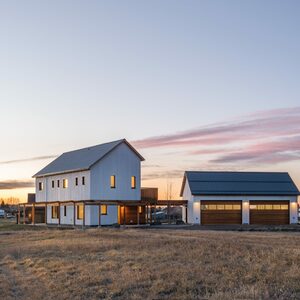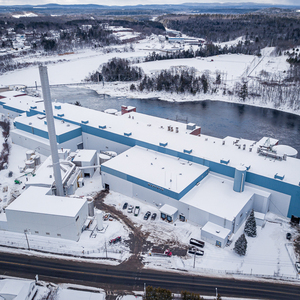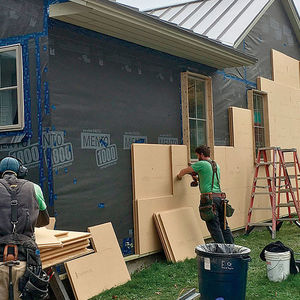
The design goal for this wall and roof assembly was to use three emerging European wood construction technologies that are starting to enter the U.S. market: cross-laminated timber (CLT), wood fiber insulation, and heat-treated wood siding. The objective was to maximize the building’s performance by creating a tight (R-38 wall, R-60 roof, .8 ACH50), resilient enclosure, while driving down the project’s carbon footprint by using biogenic, carbon-storing, structural, insulating materials.
The 100-mm-thick CLT panels provide a highly exact structural system, and the interior finish. Based on our BIM models, they were pre-cut by KLH in Austria and installed onsite in a matter of days. The wood fiber insulation was field-installed (9-1/4 in. in the walls, 16 in. in roof)—although we have discussed combining the CLT panel with our wood fiber board product to create one pre-fab assembly package. Actually, our vision for the second-generation panel includes CLT, wood fiber insulation, windows, WRB, and strapping. These assemblies would be pre-fabricated at OPAL Build in Belfast, Maine, and designed to be delivered onsite ready to go up, like the current iteration of panels.
A few notes on materials
The CLT panel is easy to handle and highly vapor permeable (0.05 to 0.6 U.S. perms); and the thick layer of exterior insulation we add can be carved out to integrate gutters, downspouts, and electrical runs. Because CLT and wood fiber insulation are both wood-based products they manage moisture similarly, creating a vapor-open assembly that allows moisture to pass through without getting trapped. This contrasts with combining a wood structural system with a foam plastic insulation layer that has no permeability and could result in moisture getting trapped in the assembly, potentially causing rot or mold.
The CLT panels are also the air barrier for both the roof and wall; the joints are…
Weekly Newsletter
Get building science and energy efficiency advice, plus special offers, in your inbox.

This article is only available to GBA Prime Members
Sign up for a free trial and get instant access to this article as well as GBA’s complete library of premium articles and construction details.
Start Free TrialAlready a member? Log in














5 Comments
I read it's around 3g/ton/km of CO2 for ocean shipping vs around 80grams for the same via truck.
That gutter system seems to cut right into your insulation path pretty heavily in the image. Maybe it's just the picture?
yes, that gutter gives me heartburn
I like these assemblies, but I'm a bit puzzled by how the roof works. The CLT and wood fibre insulation are described as being quite vapour-open, but they terminate in a vent space under the sheathing which has no obvious way of dispersing any moisture. Maybe I'm just not understanding it.
I guess you also have a greater tolerance for risk than me. I would only consider using a concealed gutter on a roof with overhangs, where the consequences of any failure are much lower.
This is a cool technical exercise and I appreciate the details of the assembly.
It boggles my mind why you would ship CLTs across the ocean to build a structure in North America when there's a CLT manufacturer in Montana (https://www.smartlam.com/manufacturing-facilities/). I guess it depends on how close to the port the building is.
EDIT: never mind, you answered this in the last paragraph, I missed it!
It's a shame that it's hard to get cargo shipped by train in the US as a small business. That would make north American sourcing more competitive.
Log in or become a member to post a comment.
Sign up Log in